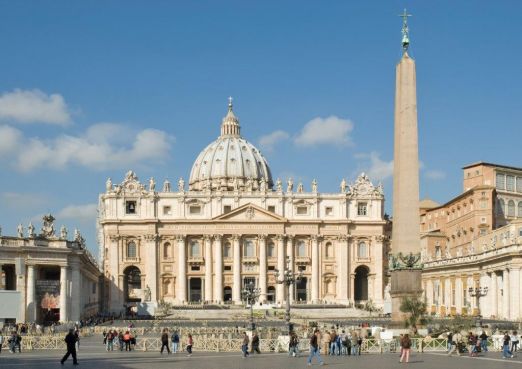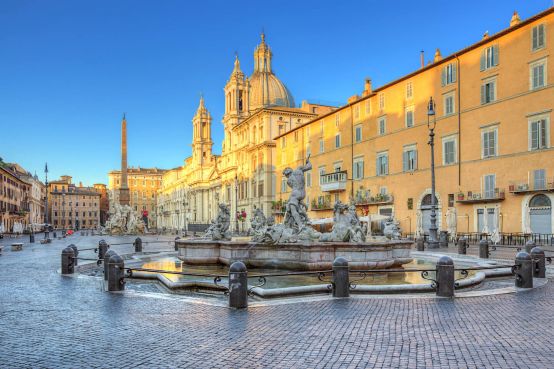There are so many museums in Rome that, in order to talk about them, we need to divide them based on what they exhibit: there's archaeological museums, modern art museums, contemporary art museums or scientific museums. Villas, galleries, archaeological complexes are but some examples of the establishments that make Rome a unique open air museum.
The Vatican Museums, capitoline museums, and the Villa Borghese Gallery which houses the Renaissance collection of Cardinal Scipione Borghese are just some of the best art museums worth visiting in Rome, but the choice is vast and it also includes places such as Colonna Gallery, the National Ancient Art Gallery, with its two headquarters in Palazzo Corsini and Palazzo Barberini, or the Doria Pamphili Gallery, which houses artwork by Caravaggio, Tiziano and Raphael and many other great maestros.
If you want to be sure to visit the best museums in Rome, call us: we'll plan a personalised itinerary based on your needs. You'll be able to see all the best art museums without wasting time or missing out on unique opportunities.
Galleria Borghese, Villa Borghese
Drawn from the collection assembled by Cardinal Scipione Borghese in the late sixteenth and early seventeenth centuries, the Borghese Gallery includes major works by Raphael, Rubens, Titian, Caravaggio, Bernini, Antonello da Messina and Canova.
Housed in the 'casino' (summerhouse) of the Villa Borghese, which was built between 1613 and 1616, the collection was purchased by the state with the villa and its contents in 1902. Recently reopened following a fourteen-year renovation program, the architecture and decoration of the gallery create the perfect setting for the magnificent paintings and sculptures.
closed on Mondays
Galleria Colonna - Via della Pilotta
The construction of the magnificent Galleria Colonna in the huge complex of Palazzo Colonna began in 1654 and took 50 years, its grandeur reflecting the nobility of the Colonna family.
The gallery was conceived as a work of art in itself and the magnificent Baroque setting contributes to the presentation of the displayed masterpieces by artists including Lorenzo Monaco, Bronzino, Ghirlandaio, Salviati, Veronese, Palma il Vecchio, Jacopo and Domenico Tintoretto, Pietro da Cortona, Annibale Carracci, Francesco Albani, Guercino, Guido Reni, Carlo Maratta, Gaspard Dughet, Crescenzio Onofri, Girolamo Muziano, and Pompeo Batoni.
Open on Saturday morning
Barberini Palace and National Gallery of Antique Art
Via Quattro Fontane 13
The Galleria Nazionale d'Arte Antica is located on two sites; the Palazzo Corsini and the Palazzo Barberini. One of the grandest palaces in Rome, the Palazzo Barberini was built in the early seventeenth century, showing the architectural influence and design of Maderno, Borromini and Bernini.
The interior is equally impressive, featuring the most famous work of Pietro da Cortona on the ceiling of the Salone, which took six years to complete. The Barberini collection is mainly of Italian painting of the thirteenth to sixteenth centuries with works by Fra Angelico, Filippo Lippi, Lorenzo Lotto, Andrea del Sarto, Perugino, Caravaggio, Canaletto and Raphael.
closed on Mondays
Doria Pamphili Gallery
Piazza del Collegio Romano
The recently refurbished Galleria, inside the majestic Palazzo Doria Pamphili dating from the fifteenth century, houses one of Rome's most distinguished private art collections, including works by Caravaggio, Titian, Raphael, Velázquez, Lippi, Lotto, Rubens, Guercino, Reni, Parmigianino, Bellini and Brueghel.
Open on Sat & Sun
Modern National Gallery
Viale delle Belle Arti
The Modern National Gallery houses the most important Italian collection of paintings and sculptures of the nineteenth and twentieth centuries. Works by artists belonging to most of the contemporary art movements are represented as well as neo-classicism, romanticism and Tuscan Macchiaoli impressionism.
The gallery's exhibits include works by Goya, Géricault, Delacroix, Blake, Renoir, Rossetti, Courbet, Van Gogh, Degas, Monet, Cezanne, Modigliani, Mondrian, Duchamp, de Chirico, Cara, Miró, Kandinsky and Klimt.
closed on Mondays
Gallery of the National Academy of St. Luca
Via dell'Accademia di S. Luca
One of Rome's most prestigious galleries, Galleria dell'Accademia di San Luca was founded as an art academy in 1478 with the statute that "every member should donate a work to its perpetual memory". Through these gifts, combined with other bequests and donations, the gallery contains an eclectic collection of classical works by artists such as Raphael, Canova, van Dyck, Titian, Guercino, il Sassoferrato, Reni and Pietro da Cortona.
closed on Sundays
Corsini Gallery
Via della Lungara
The other site of the Galleria Nazionale d'Arte Antica, the Palazzo Corsini was originally built in the fifteenth century, but was considerably remodelled in the eighteenth. It is a relatively small, attractive gallery containing a large oeuvre of seventeenth and eighteenth century regional Italian painting as well as works by Rubens, Murrillo, Poussin, Brueghel and Caravaggio.
Open Thu to Sun
Spada Gallery
Piazza Capo di Ferro
The Galleria Spada, behind the majestic sixteenth century Palazzo Spada, exhibits the Spada family collection of works mainly from the seventeenth and eighteenth centuries, as well as some second and third century Roman sculptures.
Artists featured in the collection include Rubens, Durer, Caravaggio, Guercino, Domenichino, Guido Reni, Carracci, Salvator Rosa, Passarotti, Parmigianino, Solimena and del Sarto. In the General Council Chamber of the Palazzo is a colossal statue of Pompey, which is traditionally the one at the foot of which Julius Caesar was murdered.
closed on Tuesdays
Musei Capitolini
Piazza del Campidoglio 1
The collection of the Musei Capitolini is one of the oldest in the world. It was started in 1471 by Pope Sixtus IV who presented the city with a number of bronze statues. It now houses a collection of Roman sculptures, such as the famous 'Lupa Capitolina', inscriptions, coins, mosaics, and objects connected with everyday life. The collection also contains Greek, Etruscan and Egyptian works of art.
The museum's collection of marble sculptures and inscriptions was greatly enlarged in the 17th and 18th centuries by gifts from private collections. After Rome became Italy's capital in the 19th century, a great number of artefacts, found whilst digging the foundations for the city's new quarters, joined the collection.
The collection is exhibited in two palaces: the 17th-century Museo Capitolino and the 15th-century Palazzo dei Conservatori, which also houses the famous Conservatori Apartment well known for its large frescoes. The Palazzo dei Conservatori has been enlarged twice this century, once in 1925 and again in 1950.
An underground gallery, excavated in the 1940s, houses a collection of Latin and Greek inscriptions. The painting gallery or Pinacoteca is famous for its Italian and foreign masterpieces by such artists as Titian, Veronese, Tintoretto, Caravaggio and Rubens.
closed on Mondays
Etruscan National Museum of Villa Giulia
p.le di Villa Giulia, 9
Villa Giulia was built for pope Julius III between 1550 and 1555, and many of the most important architects, painters and decorators of the period, from Vasari to Vignola and Ammannati contributed to its execution. The complex of the villa includes two courtyards divided by a nymphaeum which originally was a proper water theatre.
The interiors of the villa were richly decorated with frescoes, stuccoes, polychrome marbles, and statues. After the pope's death the villa was inherited by his brother and later confiscated by Paul IV in 1557. The first restoration works started under Pius IV's pontificate, and the villa was destined to be residence of illustrious guests.
New restoration works were carried out in the second half of the 18th-century by Clement XIV and Pius VI. Villa Giulia officially became a museum in 1889. After 1910, following some changes of the urban planning of the area, two new wings of the museum were built, and later on they were connected to the hemicycle of the villa by a hanging gallery.
Today, Villa Giulia is the most representative Etruscan museum in Italy. The pieces on display are arranged according to a topographic criterion and grouped by their place of origin, except for some collections which are exhibited according to a typological viewpoint.
The Hall of Venus is devoted to the material from Pyrgi including remarkable evidences from the great Etruscan sanctuary of Leucotea-Ilizia; among the numerous sculptures from the precious polychrome terracotta decoration covering the wooden structure of the two temples of the sanctuary, remarkable are the famed pediment high relief portraying the Greek legend of the Seven against Thebes, and the late 6th-century B.C. gold leaves with Etruscan and Phoenician inscriptions.
New exhibition rooms displaying ceramics, bronzes and gold-works from the Castellani Collection as well as a section devoted to the Villa of pope Julius III and the history of the museum are being arranged.
closed on Mondays
The Palatine Museum
via di San Gregorio
Re-opened to the public after 13 years, this museum displays detached frescos and finds which span the history of Rome from her origin to the Imperial age. On the first floor: Iron age and Republican period finds. On the second floor: detached frescos and inlaid works coming from the Domus Transitoria, the Imperial age statues of Augustus, Adrian and Anthony, a Polycletus' lance-bearer fragments and the superb clay architectural elements once belonging to Augustan buildings.
open daily
National Museum of Castel Sant'Angelo
lungotevere Castello, 50
Originally intended as a mausoleum by the Emperor Hadrian (117-138 AD), Castel Sant'Angelo became, in later centuries, the bastion of the Papal State, both literally and metaphorically. It is now possible to visit the interior of the fortress, which also used to be a sadly renowned prison.
It is possible to visit the various rooms decorated with 16th-century frescos (the Apollo Hall, the Paul's Hall, the Perseus Hall, the Cupid and Psyche Hall), the prison, the collection of antique weapons, and the picture gallery (works by Carlo Crivelli, Luca Signorelli, Bartolomeo Montagna)
open daily












